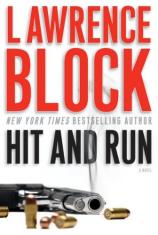Hit and Run
Review
Hit and Run
There is an 800-pound elephant in the room this political
season, and it makes people so queasy they don’t want to talk
or even think about it. But it’s impossible to ignore since
this year marks the 40th anniversary of the assassinations of Dr.
Martin Luther King, Jr. and Senator Robert F. Kennedy.
Great fiction reflects the time in which it is written. And great
fiction is fearless. Richard Condon wrote a novel called THE
MANCHURIAN CANDIDATE, which became a classic film in 1962. The
movie was pulled from public viewing for 25 years after the murder
of President John F. Kennedy. But no sane person would say that
Condon and director John Frankenheimer’s fiction had anything
to do with the tragic events in Dallas.
Now in 2008, veteran mystery writer Lawrence Block has written a
novel in which his hit man, Keller, is in Des Moines, Iowa, on
assignment when the African American governor of Ohio, John Tatum
Longford, is assassinated while exploring a run for the White
House. And Keller has been fit for the frame. Of course, this book
was written months before Senator Barack Obama began his meteoric
rise to the Democratic presidential nomination.
HIT AND RUN is not a political thriller. After it happens, the
assassination and its political or social significance is barely
mentioned. That is not what the book is about. This is a noir story
about the innocent man trapped. Yet the paranoia that has been
present in the American psyche since those dark days of Dallas and
Memphis and the pantry of the Ambassador Hotel lingers faintly in
the background here, like a discordant jazz soundtrack from a
classic film noir.
For five decades, Block has been writing mysteries and is one of
the greatest writers in the history of American letters to work in
this genre. Whether in the dark novels of alcoholic PI Matthew
Scudder or the lighter books involving burglar Bernie Rhodenbarr,
Block has consistently proven he deserves his place in the pantheon
of great American mystery writers alongside Ed McBain, Elmore
Leonard, Donald Westlake and Robert B. Parker.
So those of us who are fans of Block expect good, extremely
well-written books. But by page 28 it becomes apparent that HIT AND
RUN is not merely a good book but a great book in the noir
tradition. And then it does something truly amazing: it transcends
that dark tradition to become a novel of redemption and hope.
Hit man John Paul Keller was first introduced to us in a
Playboy short story many years ago. Like a corporate
downsizing consultant, he has an unpleasant job to do. He does it
very well but does not particularly enjoy killing people. Keller
does evil work but is actually a nice, apparently normal guy who
readers can’t help but root for.
Keller is now looking forward to retirement with his beloved stamp
collecting hobby when he reluctantly agrees to “the last
job.” You know trouble will ensue when something is the last
job. And it does. He immediately senses danger when he is escorted
around Des Moines by a mystery man working for somebody named
“Al.” But Keller is always careful where he leaves his
prints.
Then the assassination occurs and Keller wonders, “If you
wanted to frame someone for murder, why not pick a murderer? Hire
him to kill some nonentity, and time it so that he’s in the
right place at the right time, and then frame him for the real
killing, the important killing.” Shades of our collective
paranoia.
Sure enough, Keller’s face is soon on every TV channel 24/7.
“He was on his own,” Block simply writes. Now the most
wanted man in America, the hit man who didn’t make a hit, is
stuck with $200 in cash and a rented car with stolen plates. He has
nobody he can trust and must make the 1,000-mile dash home to
safety in New York City. Throughout his career, Keller has worked
hard to keep his home city separate from his professional life.
Initially he convinces himself he will be fine once he makes it
home.
But about halfway through his journey east, the dark truth sets in.
Block writes with concrete simplicity: “It was over, he saw
now… But however much people both in and out of the city
might prefer to think otherwise, New York was part of America. New
Yorkers watched the same newscasts and read the same newspaper
stories… He’d come as far as he had in life by staying
out of the spotlight, and now he was in it and that was the end of
it… The end of John Paul Keller.”
Block here has worked a modern story out of two classic noir
themes: the Trapped Man made famous by Cornell Woolrich and the
Wrong Man worked to perfection by Alfred Hitchcock. We follow
Keller on the run as he travels a hundred miles at a time with no
destination, his days spent hiding in movie theaters and nights
spent in little motels, sleeping occasionally on sheets recently
abandoned by adulterous couples, constantly waiting to be
recognized or for his money to run out, whichever comes
first.
If this were a typical noir story, we would follow Keller down that
Lost Highway until the road inevitably ends in The Big Sleep. But
Block is too good a writer to take the easy way out. And
let’s face it, Keller might be a bad man, but he’s our
bad guy. We like him despite what he does as only a mother can.
After all, he makes sure to leave his fast food wrappers in the
trash cans when finished and always has time to rescue a damsel in
distress.
This is when HIT AND RUN takes a few incredible twists that I will
leave for you to discover and enjoy. Suffice to say the Block
manages to inject a note of redemption, hope and love into a really
dark story. And while the darkness and paranoia are real and cannot
be denied, perhaps at the end of the day, real change is still
possible for a hit man and the rest of us.
Lawrence Block has written a novel that transcends the mystery
genre and manages to be topical without being sensational. It is
one of the greatest accomplishments of his long storied
career.
Reviewed by Tom Callahan on January 22, 2011





